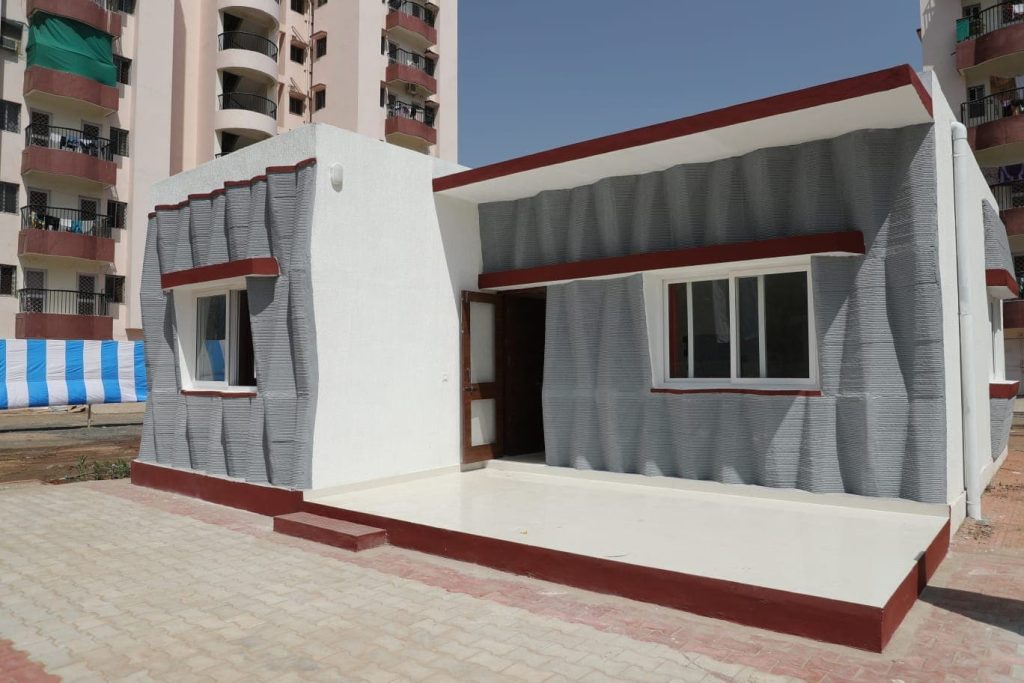Chennai-based start-up Tvasta Manufacturing Solutions has begun working with India Cements to develop a new, more sustainable construction 3D printing material.
As part of a recently-signed ‘strategic collaboration’ deal, the firms have agreed to exchange technologies and conduct joint R&D, with the aim of coming up with a novel, eco-friendly cement formulation. Having worked on both private projects and those for the Indian Air Force together, the companies now intend to extend their partnership, as a means of making Indian construction less resource-intensive.
“We are excited that Tvasta Manufacturing’s technology delivers a cost-effective construction method that offers quicker turn-arounds as compared to conventional methods,” Rupa Gurunath, Director of India Cements, told the Times of India. “But what we are particularly enthusiastic about is that this methodology is more eco-friendly, with lower consumption of water and sand, two of our most precious resources.”
“‘Sustainability’ is a new phenomenon for the construction industry, and we are privileged that this partnership is just about to bring it within the easy reach of the common man in our country.”
Tvasta Manufacturing’s AM ambitions
Founded by three IIT-Madras alumni, Tvasta Manufacturing was incubated there until 2016, before the firm was eventually spun-out. Initially, the company offered consultancy services to those Indian businesses seeking to integrate 3D printing into their supply chains, but they soon realized that they could utilize their expertise to develop their own products.
After iterating their technology to the point that they were able to create India’s first 3D printed home in 2020, the Tvasta Manufacturing team soon began to commercialize it in the form of a production system. With this machine, the firm’s founders say they’ve managed to reduce their process’ material consumption, as well as optimizing the properties of the structures they’re able to build with it.
While little has been made public about the workings of Tvasta Manufacturing’s 3D printer, it’s understood to deliver cost and lead time benefits over traditional construction technologies. From what we do know, the company has established an ‘end-to-end’ portfolio, composed of machines, software and materials, which it says is capable of delivering custom infrastructure efficiently, and at scale.

A continued India Cements collaboration
Already, Tvasta Manufacturing and India Cements have worked together on a number of projects, including the construction of the Indian Army’s first 3D printed houses. Built in Gandhinagar, Gujarat, alongside the Army’s Military Engineering Services (MES), the 700 square foot abodes were completed inside three weeks, and designed to meet the accommodation needs of India’s Armed Forces.
At the time, the builds were said to have showcased the ability of Tvasta Manufacturing’s technology, to not only construct buildings rapidly enough to meet urgent housing needs, but to make them in-line with Zone-3 earthquake standards.
However, through its newly-agreed partnership with India Cements, the company is now seeking to make its process more sustainable. The technology is currently 30% less water and sand-intensive than conventional house-building methods, but the firms believe that with further digitization and tweaks to its feedstock, it could be turned into an approach with wider appeal to the construction industry.
“We are confident that this partnership will significantly improve our technology’s orientation to sustainability, resulting in highly-efficient and targeted solutions,” added C. Vidyashankar, COO of Tvasta Manufacturing Solutions. “Not only will this lead to an expedited unification between technology, sustainability and construction in India, but with the support of India Cements, this will pave the way for such a unification in the global markets as well.”

Sustainability in concrete 3D printing
With concrete 3D printing starting to make inroads into mainstream construction, the attention of researchers and the industry’s early market leaders, has begun to turn to perfecting the materials behind the process. Engineers at Technische Universität Berlin and Brunel University, for instance, have developed a 3D printing material made from recycled glass, with strong sustainability credentials.
Working with 3D printer manufacture COBOD, Mexican material developer CEMEX has also come up with a means of making regular concrete 3D printable. By adding its D.fab admixture to everyday concrete, the firm is said to have created a material that’s not only more sustainable, but has unique qualities that allow it to “gain shape instantaneously,” yielding cost and lead time advantages.
Elsewhere, researchers at fellow India-based technology institute IIT Guwahati have even managed to develop a way of 3D printing waste into eco-friendly structures. Using industrial leftovers as a binder, the team were able to print a piece of ‘urban furniture’ earlier this year, in a way that unlocked design optimization and material consumption benefits.
To stay up to date with the latest 3D printing news, don’t forget to subscribe to the 3D Printing Industry newsletter or follow us on Twitter or liking our page on Facebook.
For a deeper dive into additive manufacturing, you can now subscribe to our Youtube channel, featuring discussion, debriefs, and shots of 3D printing in-action.
Are you looking for a job in the additive manufacturing industry? Visit 3D Printing Jobs for a selection of roles in the industry.
Featured image shows India Cements’ Rupa Gurunath and Tvasta’s C. Vidyashankar signing a Memorandum of Understanding (MoU) between the firms in Chennai. Photo via India Cements.



